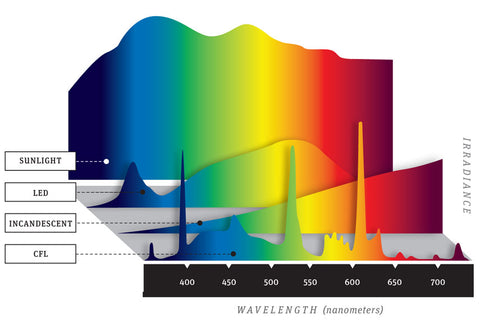Advances in Technology Causing more Blue Light Exposure than Ever Before
Posted by Daniel Giavedoni on March 25, 2015 . 0 Comments
Florescent bulbs and Light-Emitting Diodes (LED) lighting have become increasingly popular in recent years - due to their lower cost and potential environmental benefits. However these savings come with a hidden cost. While they have several benefits over old style incandescent bulbs you may have noticed that LED lights or florescent lights do not produce the same warm yellow color, instead producing isa whiter cooler light. This effect can be attributed to the type of light emitted - a lot more light in the violet and blue end of the visible light spectrum. Take a look at this comparison chart generated by Popular Mechanics.

Image Credit: Popular Mechanics, 2015
As you can see - the light produced by LED and CFL lighting appears to have localized peaks in the blue range of the spectrum, while the incandescent light peaks at the red portion of the spectrum.
To make matters worse, the backlights in our TVs and computer screens have also been changing. Monitors and screens that were once backlit by cold cathode fluorescent lamp (CCFL) are now being lit with LED lighting. While the spectrum from the LED backlight can vary substantially depending on the types used, in one study conducted by the Centre for Chronobiology at the University of Basel, the new monitors were producing twice as much blue light as compared to an older fluorescent monitor. This exposure had a measurable effect on the volunteers and resulted in a delayed rise in melatonin levels and a suppression of both subjective and objective levels of sleepiness.
From the a New York Times article about the study The finding adds to a series of others suggesting, though certainly not proving, that exposure to blue light may keep us more awake and alert, partly by suppressing production of melatonin. An LED screen bright enough and big enough “could be giving you an alert stimulus at a time that will frustrate your body’s ability to go to sleep later,” said Dr. Brainard. “When you turn it off, it doesn’t mean that instantly the alerting effects go away. There’s an underlying biology that’s stimulated”
While the wavelength spectrum does vary from product to product, there is a concern that newer technologies are exposing us to more and more blue light. While we don’t know all the ways in which lighting from technology is impacts us we do know that additional studies will be undertaken, that will hopefully shed light on this intriguing phenomenon.
Post Comment.